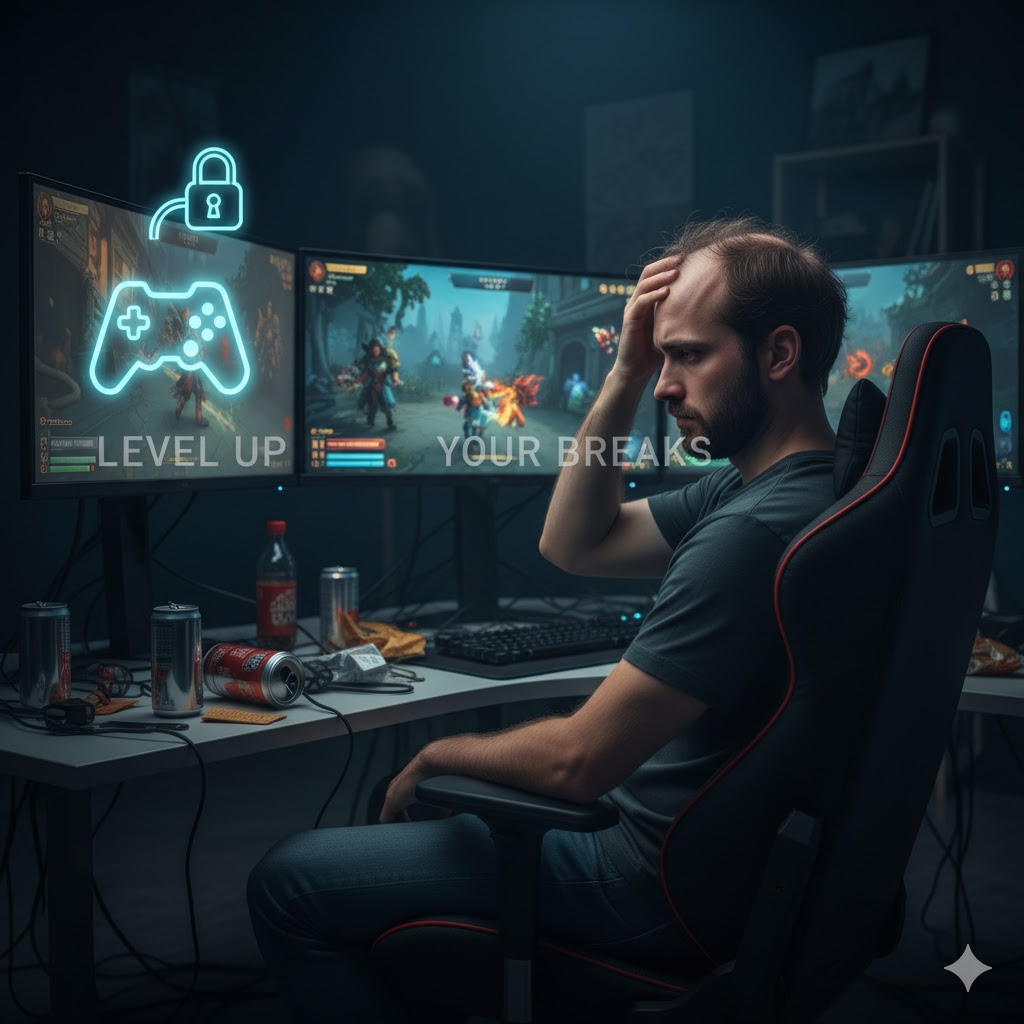In the digital age, long hours in front of screens have become the norm—especially for gamers, streamers, and content creators. But while the impact of screen time on sleep, posture, and eye health has been widely discussed, a new concern is emerging in clinical settings: Could excessive digital stimulation be linked to hair thinning?
At ZMD Hair, we believe in treating the root cause of hair loss—not just the symptom. In this blog, we explore the complex relationship between screen addiction, stress, lifestyle habits, and hair health, especially among those spending extended time in gaming or high-stimulus digital environments.
The Growing Prevalence of Screen Dependency
The average person now spends over 7 hours a day in front of a screen. For gamers, developers, and online creators, that number can easily exceed 10 hours. This constant exposure to digital stimuli—often accompanied by poor posture, irregular sleep, and emotional highs and lows—can impact multiple biological systems, including those critical to hair growth.
Common lifestyle patterns associated with screen overuse include:
- Late-night gaming marathons
- Irregular meals or snacking
- Sedentary behavior
- Reduced exposure to sunlight
- Elevated stress during competitive play
These behaviors can influence hormonal balance, blood circulation, and inflammation—factors that directly affect the hair follicle’s ability to function and thrive.
How Screen Addiction May Impact Hair Health
1. Disrupted Sleep-Wake Cycles (Circadian Rhythm)
Excessive screen use—especially late at night—suppresses melatonin, a hormone essential for sleep regulation. Poor-quality sleep disrupts the body’s repair mechanisms, including those related to scalp health and follicular regeneration.
During deep sleep stages, the body performs key cellular restoration processes. When these are interrupted, the anagen (growth) phase of hair may shorten, and follicles can prematurely enter telogen (resting) phase—leading to increased shedding.
2. Elevated Cortisol and Chronic Stress
High-stakes gaming, social comparison online, and prolonged screen exposure can increase cortisol levels. Chronically elevated cortisol triggers inflammation, restricts blood flow to the scalp, and contributes to telogen effluvium—a stress-induced form of hair loss.
At ZMD Hair, we’ve observed more young adults reporting diffuse hair thinning, with no clear medical explanation—until lifestyle stress is factored in.
3. Nutritional Deficiencies Linked to Screen Habits
Long gaming sessions often mean skipped meals or consumption of processed snacks. Diets lacking iron, biotin, protein, and vitamin D can significantly weaken hair strands and impair follicular performance.
A 2021 study published in Nutrients confirmed that digital overusers are more likely to be deficient in key micronutrients tied to healthy hair.
Scalp Health in Sedentary Lifestyles
Sitting for long hours reduces blood flow throughout the body—including the scalp. Without adequate circulation, hair follicles receive less oxygen and fewer nutrients. Over time, this can lead to miniaturized follicles, weaker shafts, and visible thinning.
In addition, poor posture (such as forward head tilt during gaming or streaming) may increase muscle tension in the neck and upper scalp area, which can further restrict microcirculation to hair follicles.
Blue Light Exposure and Oxidative Stress
Screens emit high-energy visible (HEV) blue light, which has been shown to induce oxidative stress in skin cells. While most research has focused on the face and eyes, some dermatologists believe long-term blue light exposure may contribute to inflammation in adjacent scalp areas.
Oxidative stress accelerates the aging process in skin and hair cells, potentially triggering early follicular decline and premature graying.
The Psychological Impact of Appearance in the Digital Age
Gaming and digital spaces are increasingly visual. Streamers, influencers, and competitive gamers often appear on camera or maintain a highly curated online presence. Hair plays a central role in how individuals perceive themselves—and how they’re perceived by others.
Ironically, this visual pressure may lead to more stress about hair appearance, worsening anxiety and perpetuating the cycle of hair thinning.
At ZMD Hair, we treat hair loss not just as a biological issue, but as an emotional one too. Many of our younger patients cite self-esteem concerns related to online exposure and image-based comparison.
What the Research Says
While more longitudinal data is needed, several studies suggest a link between excessive screen use and hair health:
- A 2020 study in Clinical, Cosmetic and Investigational Dermatology found that young adults with higher screen time had increased reports of seborrheic dermatitis and hair shedding.
- The Journal of Behavioral Addictions notes that screen overuse correlates with poor dietary habits, high cortisol levels, and insomnia—all known contributors to hair loss.
- A 2022 analysis suggested that oxidative stress markers were significantly elevated in gamers with digital addiction symptoms, possibly impacting scalp inflammation.
These findings support the growing hypothesis that digital overstimulation is not just a cognitive or visual issue—but a systemic one with real dermatological effects.
What You Can Do to Protect Your Hair
You don’t have to give up gaming or digital engagement to protect your scalp. But small, consistent changes can help restore balance:
Prioritize Sleep
Maintain a consistent bedtime, use blue light filters, and avoid screens at least 60 minutes before bed. Melatonin production supports not just rest, but hair growth cycles.
Manage Stress Proactively
Incorporate stress-reducing activities like deep breathing, physical activity, or mindfulness between screen sessions. Even 10-minute breaks can reduce cortisol spikes.
Eat for Your Follicles
Make sure your diet includes protein, iron, zinc, and vitamins A, D, and B-complex. If your schedule doesn’t allow for full meals during gaming, plan nutrient-dense snacks like boiled eggs, trail mix, or protein shakes.
Move Every Hour
Use a timer or gaming reminder to stretch, stand up, and do light neck movements every 60 minutes. This boosts circulation to your scalp and reduces tension in the neck and shoulders.
How ZMD Hair Supports Screen-Affected Patients
At ZMD Hair, we take a modern, science-backed approach to treating hair loss triggered by digital overstimulation. Our evaluation includes:
- Scalp imaging and trichoscopy
- Nutritional and lifestyle review
- Stress hormone testing if needed
- Customized plans including PRP therapy, LLLT, nutritional correction, and lifestyle coaching
We meet each patient where they are—even if that’s in the middle of a streaming career or competitive esports journey.
Conclusion:
Digital culture is here to stay. But your scalp health doesn’t have to suffer for it. Whether you’re a lifelong gamer or a remote worker logging long screen hours, it’s time to recognize the real impact of digital overload on hair health.
At ZMD Hair, we help patients identify hidden triggers like stress, blue light, and circulation issues that may be quietly sabotaging their follicles. You don’t have to choose between the digital world and your hair—you just need the right guidance and care.
📞 Is screen stress thinning your hair? Let’s find out.
Visit ZMDHair.com or call now to schedule a private consultation.




